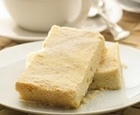|
British Tea Time Scottish Shortcakes Easy to buy, but better to make. Buttery, crunchy short-bread cookies. 1 stick butter Preheat oven to 350. Mix sugar and butter with beater. Gradually add flour, then egg yolk. Press dough into 9 x 13 pan. Cut small squares with knife. Prick each squire twice with fork. Bake for 25-30 minutes. Allow to cool for 5 minutes, then re-cut squares and remove from pan while still warm. |
Tips & Glossary Clotted Cream: a thick yellowish cream made from unpasturized cow's milk. You can make your own, although it's hard to find unpasturized cream in the U.S. Still, you'll find 3 recipes under Scones. All use pasturized cream; try to avoid "ultra" pasturized. Ploughman's Lunch: sounds romantic, like a peasant dish from medieval times, but it's a marketing gimmick from the 1970's! It's become a popular lunch in Britain now: a piece of bread, hunk of cheese, with onion, gherkin, and an apple. Our Ploughman's Soup is a take-off on that name. Roux: (“roo”), paste-like mixture of melted butter and flour, into which liquid is gradually added. Used as a thickening agent for soups and all classic French sauces. Basic Roux: melt 1 part butter and add 1 part flour. Stir continuously till it becomes paste-like. Slowly add whatever liquid your recipe calls for. Tea Time: Afternoon tea became fashionable in the mid-1600's. A light snack with sandwiches and sweets, it's served from 3-5 in a sitting room. High tea, is a light meal served from 5-6 in a dining room. ("High" because the dining table is higher than the low ones in a sitting room.) Yorkshire Pudding: from the northern county of Yorkshire, originating in the early 1700s when flour was more readily available. A pancake like batter is spooned into the drippings of a roast as it cooks. Eaten alongside the roast or as a separate course.
|

